Table of Contents
Introduction
Alejandro Viñao was born in Argentina in 1951. He studied composition with the Russian composer Jacobo Ficher in Buenos Aires, and went on to study music at the Royal Conservatory College of Music and the City University in London. Viñao has been a resident of London ever since.7 Water was premiered November 16th, 2013 at the Percussive Arts Society International Convention, in Indianapolis, Indiana. It was performed by the Eastman Percussion Ensemble directed by Michael Burritt.
Viñao’s Style
I would consider Viñao to be a “product” of 20th century composers. His compositions have many characteristics of minimalism such as orchestration/textures, repetitive rhythmic motives, and static harmonies. However, Viñao does not consider himself a minimalist. He writes:
“ Minimalism was once new because the new syntactical approach to rhythm it introduced lead to a new perception of time and space. I have never been attracted to Minimalism but I can see that it was once new. New is not what I like but what is perceptually new. By contrast, the total serialism of the 50s introduced a radically new syntax which had little perceptual relevance. So when I look back I do not consider serialism new, not even back then in the 50'. Music - for me- can only be new if it engages our perception in a new way. ” 3
Viñao’s music is much more rhythmically complex than the “classic” American minimalist composers such as Steve Reich and Phillip Glass. He develops musical ideas using similar compositional techniques as Igor Stravinsky such as stratification, juxtaposition, and synthesis to layer/build textures and ultimately create interest. Although Viñao’s music does not sound like the typical impressionist genre, he still still draws a great deal of influence from impressionist composers. He claims that Debussy and Ravel are some of his “all time favorite composers and they have written a lot of music that relates to water in some way or other.
In Water, Viñao has composed the individual lines to represent rivers. When first presented to the listener, the various rivers, appear to follow their own course, their own “independent trajectory”. As the piece develops, the rivers lead to pivotal points where they will lines up and create a rhythmic cadence. Viñao explains this as he writes, “I wanted to see if it was possible to work with multiple simultaneous times but with shorter cycles so that the pivotal points were arrived at more quickly, not just towards the end of a piece or a section, and more importantly, I wanted to control how these lines converged to these points on a bar to bar basis”.2
Rhythmic Cycles in Water
Each independent line is unique in contour but also meter. In many cases there will be multiple meters represented at one time in this music. Figure 1 shows an example of this where Viñao has three meters present at once: 14/8, 11/8, and 3/4.
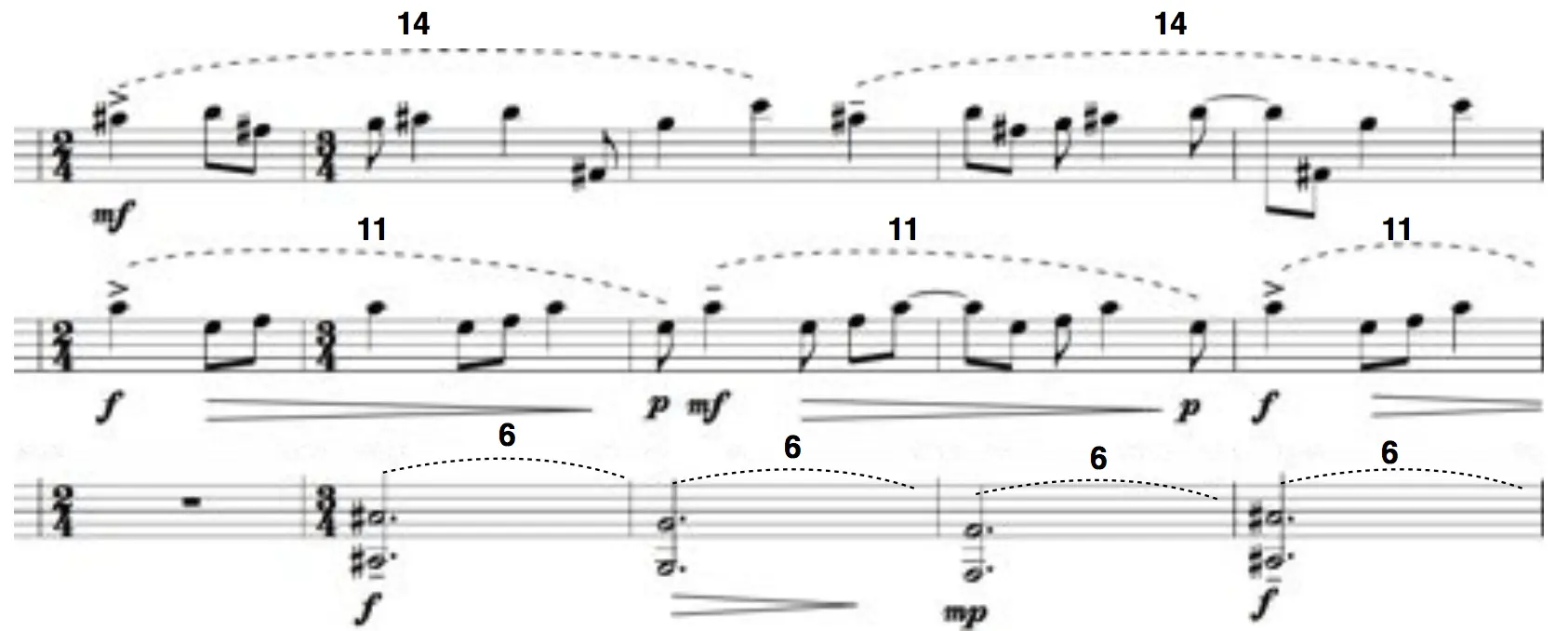
I also found it interesting that at times, a motive may be repeated and sound the exact same, however will be written in an entirely different meter. Viñao does this so that he can experiment with polyrhythms. An example of this can be found at the beginning of the first movement. Figure 2a and 2b show the exact same motive, however written in a different way.
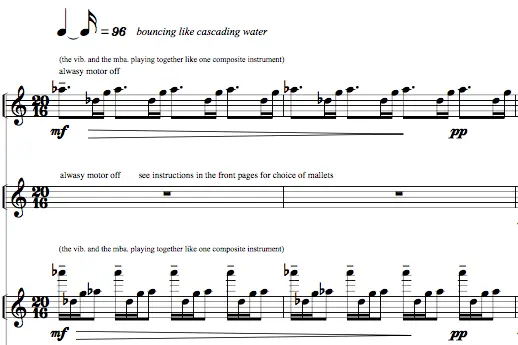
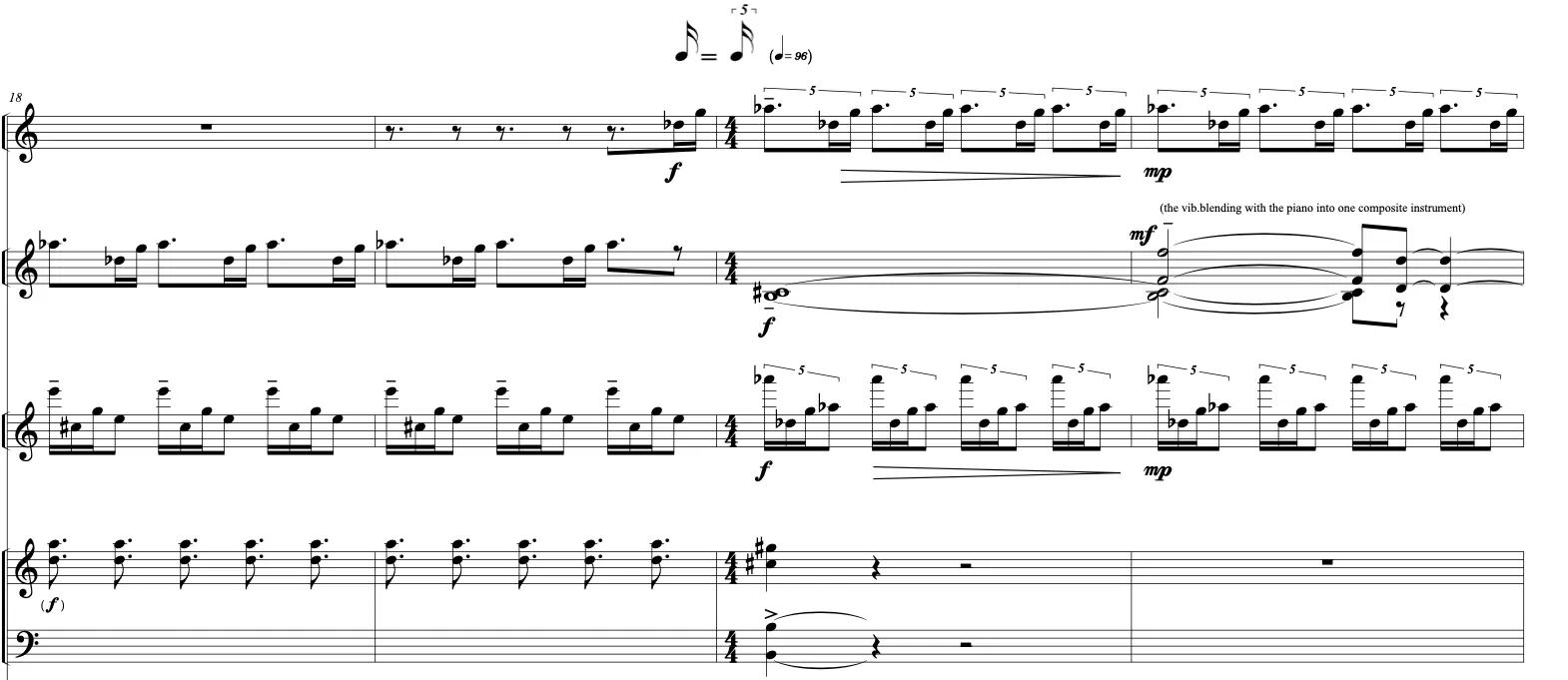
In figure 2c, Viñao does this once again however this time he also modulates tempo. It is also important to note that each of these changes occur on a rhythmic cadence, where the rhythmic cycles (called ‘Talas’ in Eastern music) finally line up.
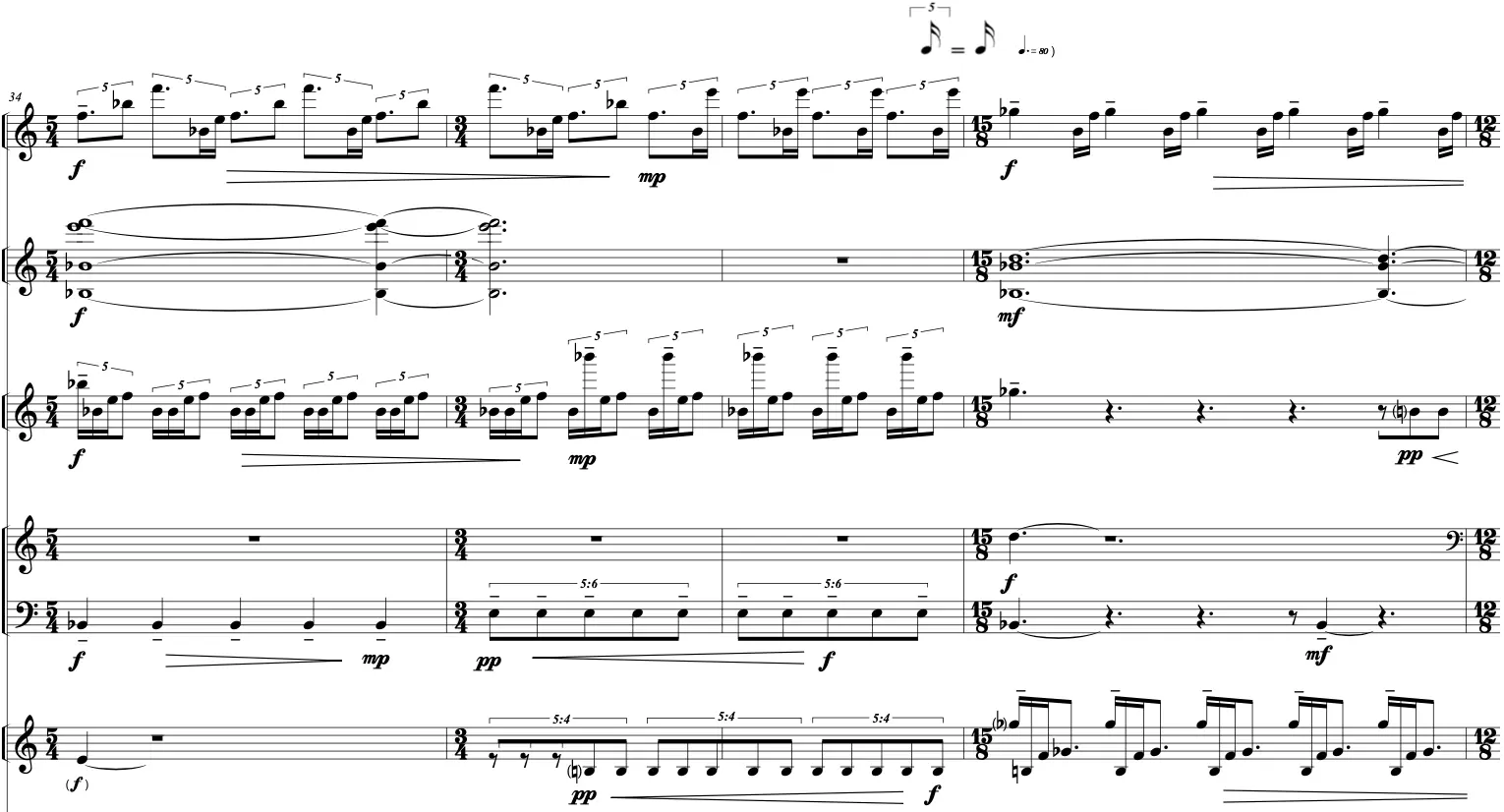
Viñao creates form in him compositions using rhythmic ambiguity and metric modulation rather than traditional harmony or chromaticism. Viñao writes:
“ The magic in baroque polyphony is that each layer is melodically independent but harmonically together. The magic in music with multiple times is that in spite of the layers appearing to not belong together in the same time, they finally arrive at a place where it is shown that they did belong together and that they were traveling together towards the same destination, albeit, following very different routes, seemingly completely independent routes. Perhaps there is a paradox there in that this process resemble the world as we experience it, populated by independent objects and people and yet everything seems to affect everything else. ” 2
Echo/Bounce Effect
Looking through the score, the words “echo” and “bounce” are written quite frequently. The echo effect functions to give individual musical lines their own sense of timing. Specifically, Viñao chooses to let short, melodic fragments continually echo within individual parts to simulate multiple time. Viñao writes:
“ The idea of bouncing and echo are very much linked together. Both ideas have to do with the way energy is dispersed or diffused. ‘Bouncing’ relates to the way mallets bounce on a percussion instrument especially on a marimba. If I ask you to ‘bounce’ off the key of a marimba you will put some energy on the way down towards the key but also use some of the same energy as it rebounds off the key as opposed to stopping that energy on its track. The rhythm need to be right, of course, to allow you to bounce. If it is too fast or too slow it will not bounce. But assuming that the rhythm is the right type, the term ‘bouncing’ will invite you as a player to control energy in a different way. The ‘echo’ is the electronic equivalent of bouncing, and in my case it comes from when I was young and played in a rock band in the late 60s and early 70s. Later on, I found the same technology that creates echo repeats in the electro-acoustic studio of the serious music world. it is an ‘import’ from the world of technology, perhaps one that qualifies ‘bouncing’, making it more mechanical, more even, more pattern oriented. ”
These echo/bounce effects can be found throughout all three movements, but I have created Figure 3 and 4 to show one of the most prominent examples.


Crossfade Effect
Another compositional technique that Viñao uses in Water is the crossfade effect, shown in figure 5.
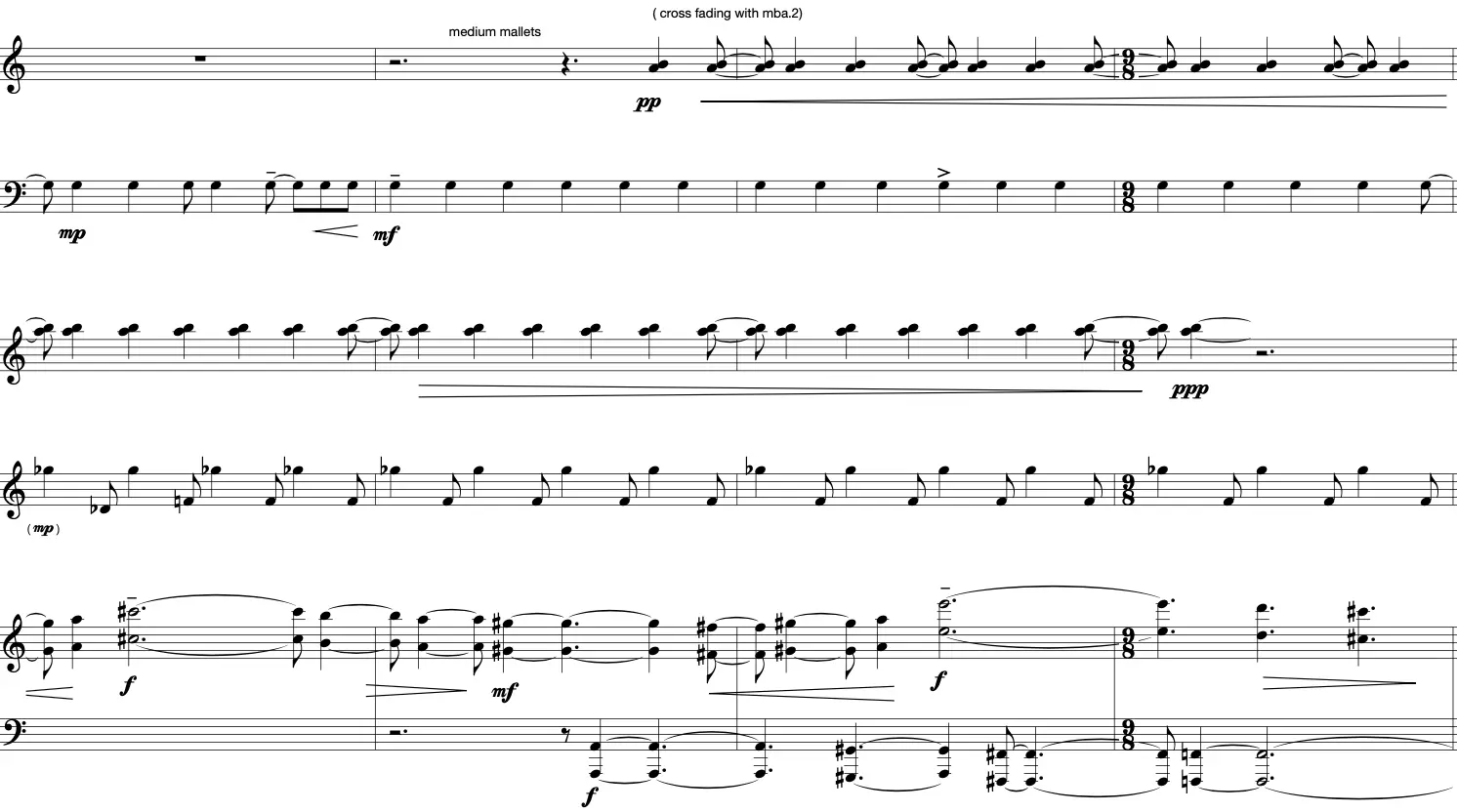
Euclidean Rhythms
As discussed before, Viñao gets a great deal of inspiration from Eastern music. One technique he uses is “Euclidean rhythms”, named after ancient Greek mathematician, Euclid. I’m not an expert in math, but essentially this is where a composer uses asymmetrical rhythmic patterns to create a cycle. Figure 4 shows an example where Viñao does this by grouping rhythms 3-2-2-2.
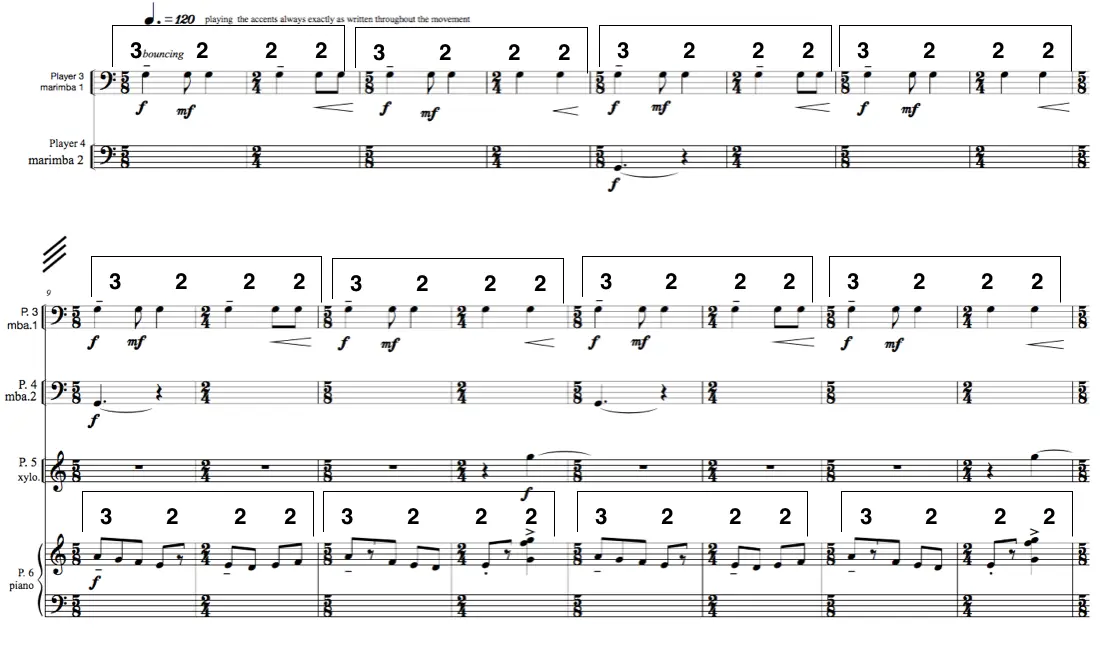
Future of Music
I may be proven wrong one day, but it seems to me that composers have exhausted the possibilities of our 12-tone Western tradition. Because of this it seems that rhythm is probably the only major area left to explore in Western music. We have already started to see a great deal of innovation in the past century. For example, Elliot Carter was one of the pioneers of metric modulation. The concept of metric modulation is becoming utilized more and more by contemporary composers. As composers combine elements of metric modulation with rhythmic ambiguity, similar to Viñao’s compositional techniques, it creates a whole new world to explore. My prediction is that when people look back on this era of Western classical music, this generation of composers will remembered for their exploration of rhythm and the synthesis of ethnic styles.
References
- 1. Buchler, Michael. "The Sonic Illusion of Metrical Consistency in Recent Minimalist Composition." 9th International Conference of Music Perception and Cognition. August 22, 2006. Accessed December 4, 2016.
- 2. Butler, Christopher L. "Understanding the Percussion Works of Alejandra Viñao: An Analysis and Performer’s Guide of Water for Percussion Ensemble." May 5, 2016. Accessed November 26, 2016. uky.edu.
- 3. Fischer, Tobias. "15 Questions to Alejandro Viñao." Tokafi. March 7, 2012. Accessed December 4, 2016.tokafi.com.
- 4. New Musical Language—Steve Reich. United States, 1987. VHS. December 16, 2013. Accessed December 4, 2016. youtube.com.
- 5. Viñao, Alejandro. "Alejandro Viñao Interviewed by Ken Ueno." Interview by Ken Ueno. Viñao.com. May 2001. Accessed December 4, 2016. vinao.com.
- 6. Viñao, Alejandro. "Alejandro Viñao Interviewed by Philip Tagney." Interview by Philip Tagney. Viñao.com. 1992. Accessed December 4, 2016. vinao.com.
- 7. Viñao, Alejandro. "Biography." Viñao.com. Accessed December 04, 2016. vinao.com.
- 8. Viñao, Alejandro. “Water: sextet for percussion with piano." Viñao.com. Accessed December 04, 2016. vinao.com.